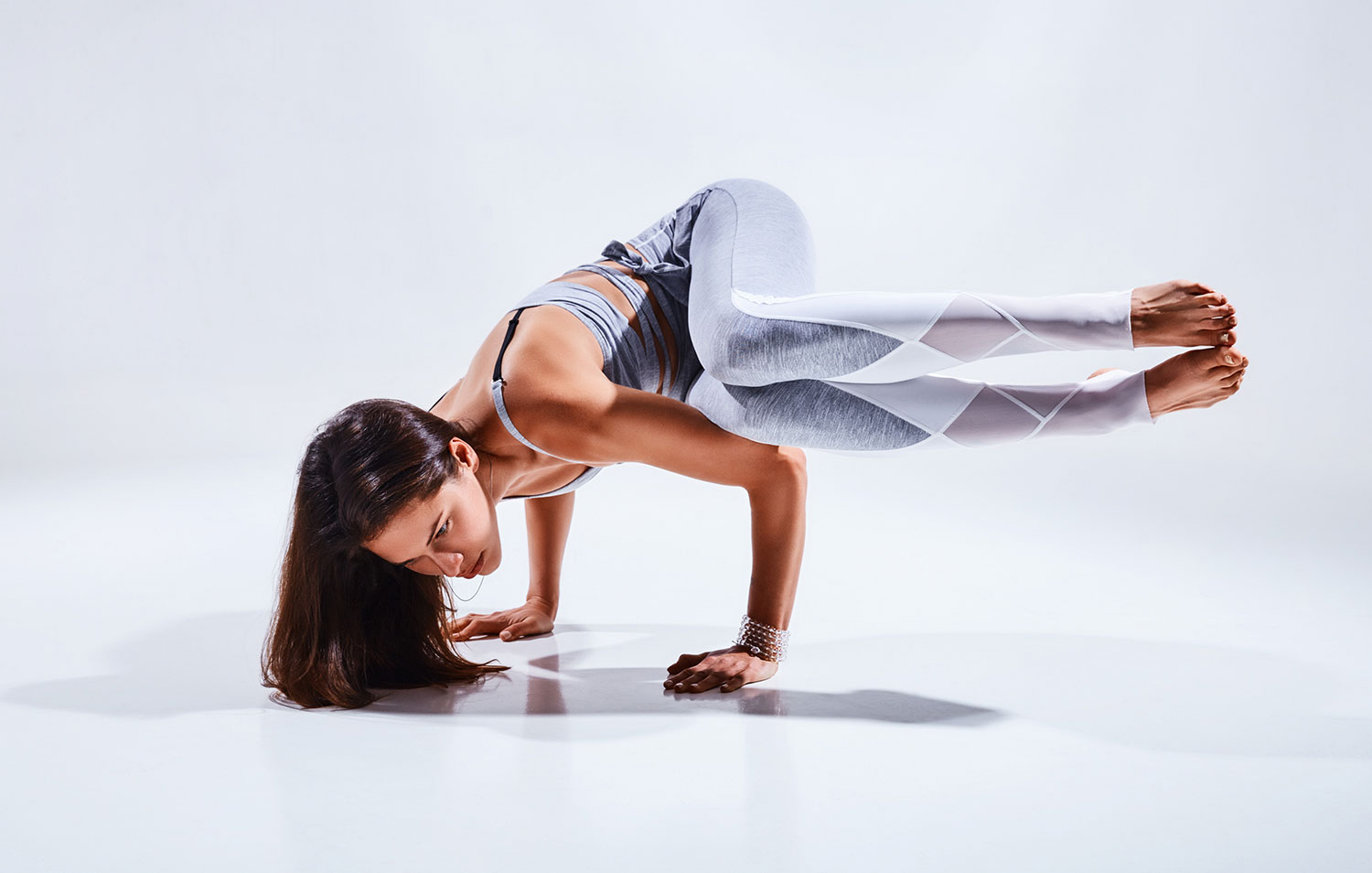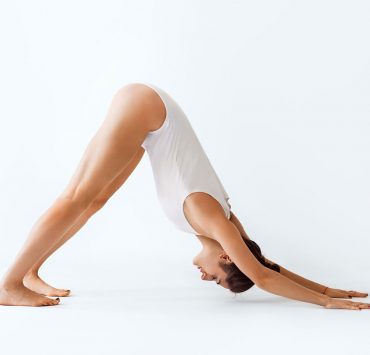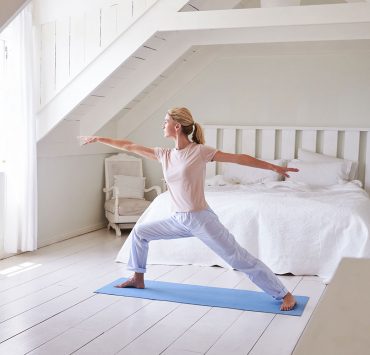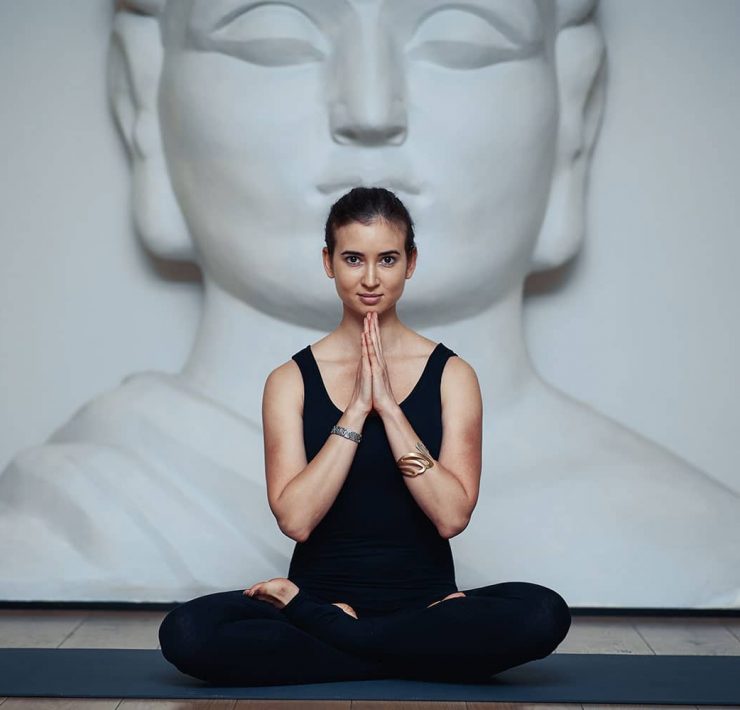
Susan views the world through a lens of spirituality, health,…
Pain from an impinged shoulder often occurs when you lift your hands over your head and the pressure of your shoulder blades rubbing against your rotator cuff limits your mobility required for many yoga poses. With normal movement, the head of your shoulder bone (the humerus) lifts and rotates into the portion of the shoulder blade called the acromion on the scapula.
Too much compression and repeated lifting of the arms may cause inflammation and pain which may become worse and cause healing to take even longer if not addressed as soon as it begins.
Healing Comes First

Before you practice any activity specifically targeting your shoulder injury, you must consult with a doctor, physical therapist, or osteopath to ensure that your shoulder mobility issues can be rehabilitated with yoga exercises. And most importantly, you must give your shoulder enough time to heal on its own before you start restrengthening to support it. Moving or putting too much activity before you’ve completely healed may make your rotator cuff and shoulder impingement worse. So if you still feel any pain at all, back off and be patient as your body rests and repairs itself.
Poses to Avoid

Any asana that will cause sharp pain in your shoulder must be stopped immediately. Other sensations to be wary of are pinching pains, compression pains, burning pains, inflammation pain, and tearing pain.
One of the main poses to avoid in your yoga practice is Chaturanga Dandasana, or Eight Angled Staff Pose. This asana requires a lot of work from your shoulders to keep your body in the correct position. Unfortunately, many shoulder injuries in yoga happen as a result of too many Chaturangas while doing the Surya Namaskar vinyasa an allowing the shoulders to sink below the chest. Avoid this pose altogether, especially while still recovering from shoulder impingements and rotator cuff injuries.
How to Modify Poses for Shoulder Impingement
Always be gentle and patient with your body as you continue your yoga practice even while you are nursing a shoulder injury. Listen to what your body is ready for without pushing or forcing yourself to perform any specific asana shape.
Any pose or movement that require wide sweeping motions should be approached slowly, carefully, and mindfully. This often will be that case when transitioning in Surya Namaskar from Tadasana (Mountain Pose) and lifting the arms overhead and then “swan diving” into Uttanasana (Forward Fold.)
Instead of raising your arms out to the sides in this, or any similar sequence, consider raising your arms up on the forward plane instead. This will reduce pressure on the head of your humerus and on the shoulder joint, and still allow you to move through the vinyasa series smoothly.
Asana for Elasticity and Range of Motion
Only start targeting yoga asana for rehabilitation of the shoulder once there is no more pain from shoulder impingement. Stretching the arms will help increase blood circulation into the muscles and joints in the shoulders, upper back, and upper arms, which will promote healing and even strengthening over time.
Garudasana — Eagle Arms

Garudasana is typically practiced with both the arms and legs intertwined. But to focus on the arms, you may also just practice Eagle arms in a seated or kneeling position.
Inhale and stretch your arms out wide to the side, and on your exhale, bring your left elbow underneath your right elbow. Intertwine your forearms so that your palms face each other (or at least have the intention of one day being able to face each other). Keep your elbows in line with your shoulders and create space by pushing your elbows forward.
Either look forward past your hands at a drishti, or focus point, or close your eyes, or rest your head into the cradle created by your arms in front of you. Stay here for a few breaths and switch the cross of your arms for the same amount of time.
Gomukhasana — Cow Face Pose

Gomukhasana is normally thought of as a hip opener with the knees stacked over each other. But the arm position of this asana is also good for stretching and opening the shoulders as well. Use a strap to help extend your reach in this pose and refrain from forcing or pulling your arm too much in any direction.
Either in full Cow Face Pose with the legs, or in any seated or kneeling position, inhale and bring your right arms up overhead and on the exhale, bend your elbow so that the back of your palm is on the base of your skull or on your upper back behind your chest. Try to move your arm on the forward plane instead of out to the side if necessary.
On your next inhale, extend your left arm to the side and bend the elbow behind your back with the palm facing out. Either hold on to your right hand or your shirt, or a yoga strap. Maintain a good grip with no need to force any upward or downward pull on the arms. Stay for a few breaths and slowly come out of the pose to switch sides.
Asana for Strengthening
A flexible and elastic body is also a stronger body so it’s important to incorporate gentle ways to strengthen a muscle that is rehabilitating after stretching it.
Marjaryasana — Cat/Cow Pose

From a table top position, and moving with your breath, create a concave arch with you spine as you inhale and a convex arch with your spine on your exhales. Get your shoulders involved by pulling them back and together on your inhales, and rounded to hug towards your front body when you exhale. If this is comfortable for your shoulders, experiment with your mobility carefully by also incorporating forward and backward rocking motions and even side to side motions.
Adho Mukha Svanasana — Downward Facing Dog Pose (Regular or With Arms on the Wall)

Ardha Mukha Svanasana, or Downward Facing Dog, is an excellent pose to strengthen the rotator cuff muscles. Either practice it the regular way with palms on the floor, or modify it with your palms on a wall instead. To do this half Downward Facing Dog variation, stand facing the wall around the distance of your own leg length away from the wall. Keep your hips over your heels as you fold forward half way. Keep your spine straight and parallel with the floor.
Always keep your palms firmly pressing against the wall, just as you would if they were pushing on the floor in a normal Down Dog. Slightly bend your elbows and turn your lower arms inwards while your upper arms spiral outwards to the heads of your arms engage into your shoulder sockets and do not over rotate inwards.
Asana for Rest and Rejuvenation
It cannot be stressed enough how much more important it is to allow enough time for the body to rest and recover while it is healing from any injury, including shoulder impingement and any strain in the rotator cuffs. Practice restorative and resting yoga poses often and for longer amounts of time than you might normally be used to in order for your body to really get into rest and digest and healing mode.
Balasana — Child’s Pose (Embryo Pose Variation)

Balasana, or Child’s pose, is often suggested for anyone to practice during a yoga class when a pose or vinyasa sequence gets too tiring or when you get out of breath or dizzy during your practice. But Child’s Pose with your arms over your head may trigger your shoulder impingement. So put less compression on your rotator cuff by practicing a version of Child’s Pose with your arms relaxed and down by your sides — sometimes this is called Embryo Pose.
Savasana — Corpse Pose

Nothing beast Savasana, or Corpse Pose, as the ultimate relaxation pose. Practiced at the start and end of your practice, and even in between poses, can help you to really check in with your body and what is really appropriate for your rehabilitation. Savasana is often described as the most difficult yoga asana to master because it really encourages you to let go of everything that will not serve you at each present moment. It’s actually much more than just laying down on your mat with your eyes closed. It’s about feeling your body and the space in and around it and how to move freely through that space — that’s the ultimate practice of yoga.
Conclusion
Trying to stick to a regular yoga practice with an injury like a shoulder impingement and pinched rotator cuffs can be frustrating and even make you feel like you are moving backwards in your practice rather than progressing. But limited range in your shoulders can actually help to make you look deeper into your own mobility and the way you approach your yoga practice. A mindful yoga practice, with enough time for rest and proper modifications, is a better practice than one that forces your body into specific shapes that might make your injury worse.
Sometimes only time and rest can truly heal your rotator cuffs, but once your body is ready, a few simple adjustments to the asana you already know and a few modifications to suit your anatomy when flowing through a vinyasa sequence can make your yoga practice more sustainable and pain-free from shoulder impingement.
What's Your Reaction?
Susan views the world through a lens of spirituality, health, and compassion. Her positive outlook on life shines through her writing, which is heavily focused on yogic living, meditation, and conscious eating.














